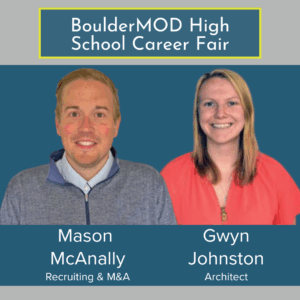EVstudio at the Boulder MOD High School Career Fair
“Gwyn, an Architect at EVstudio, and Mason, who leads Recruiting and M&A efforts for the same firm, attended the Boulder MOD High School Career Fair to help students learn about careers in architecture, engineering, and construction. Their goal focused on showing students that the AEC industry offers meaningful work, clear career pathways, and real opportunities to build practical skills. The event brought together employers, teachers, representatives from Habitat for Humanity, and students who wanted to understand how ideas move from design to construction.
Understanding the Boulder MOD Factory
Before meeting students, many attendees wanted clarity on the purpose of the Boulder MOD Factory itself, since the fair took place inside the facility. The Boulder MOD Factory serves as a hands-on learning environment within the Boulder Valley School District. The space operates as a modular construction lab where students work with building systems, fabrication tools, and digital design software. The program supports several Career and Technical Education tracks that introduce students to architecture, construction, engineering, and advanced manufacturing. Students learn by doing. They frame walls, assemble modules, and see how modular systems come together to create complete structures. These completed structures are most often done in partnership with Habitat for Humanity and support that organization’s continued efforts.
Hands-On Learning and Skill Development
The program combines digital design training with real fabrication work. Students use CAD and BIM tools to visualize projects and understand how professionals model and coordinate building components. Shop instruction and safety training help students learn woodworking, tool handling, and fabrication processes. Sustainability is also a core theme. Students study how energy use, materials, and building performance influence modern design. These activities connect students with local employers through internships, job shadows, and mentorship. The combination of digital skills, hands-on practice, and employer engagement helps students understand how buildings are designed, manufactured, and completed. The MOD Factory gives them a clear entry point into architecture, engineering, construction management, and skilled trades.
Student Engagement and Career Exploration
Once students understood the setting, they engaged directly with Gwyn and Mason about career possibilities. Some students already planned to pursue architecture or engineering, while many others were exploring new fields. Gwyn and Mason explained how modern AEC teams collaborate from early concept through final delivery. They described how design software, sustainability goals, and coordinated project management shape the built environment. Many of the students asked detailed questions and wanted examples that felt relevant to their experience, while many others expressed an interest in pursuing a degree relevant to the industry directly due to their experience with the Boulder MOD Factory.
Guidance on Career Pathways and Resources
Career paths became a major topic throughout the day. Many students wondered how to begin without feeling overwhelmed. Gwyn and Mason pointed them toward practical first steps such as enrolling in drafting or design classes, joining STEM clubs, using free student-level software offered by Autodesk, and exploring free online tools. Students received links to resources like Autodesk’s Education Community at https://www.autodesk.com/education/free-software and NCARB’s student guides at https://www.ncarb.org/become-architect to help them move forward.
Industry Tools and Role Diversity
Many students asked about software tools such as Revit, BIM 360, and energy modeling platforms. Gwyn and Mason explained how these tools help teams coordinate information, reduce risk, and communicate during complex projects. Students also learned that not every AEC career requires licensure. The industry needs project managers, designers, technicians, fabricators, visualization specialists, and people who want to solve problems across many disciplines.
A Look Inside AEC Firm Roles
Students then asked what daily work looks like inside a modern firm. Gwyn discussed how architects use sketches, models, and client meetings to solve design problems. Mason explained how recruiting supports teams by identifying talent and helping new hires develop long-term careers. These examples helped students see how different roles contribute to the same goal.
Strengthening the Future of the AEC Industry
Events like the Boulder MOD High School Career Fair help students gain clarity about their interests while giving employers the chance to invest in emerging talent. The fair strengthened EVstudios’ commitment to supporting the region and encouraging the next generation of AEC professionals. Experiences like this help students imagine how they might design, build, and improve the spaces that shape their communities.”










